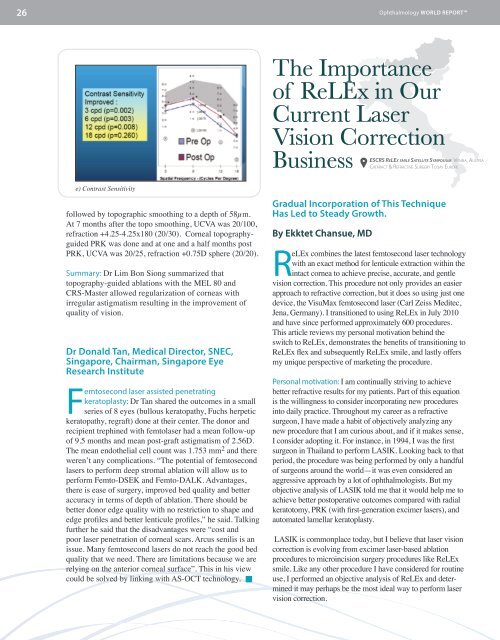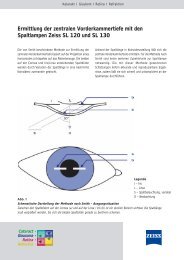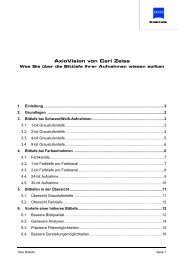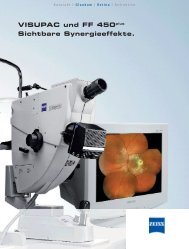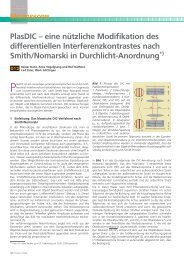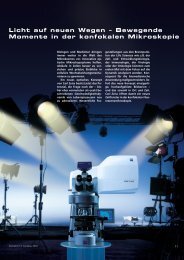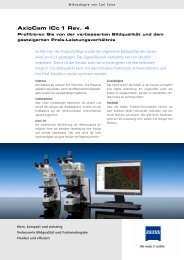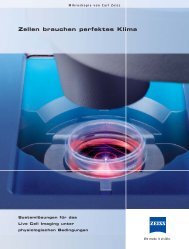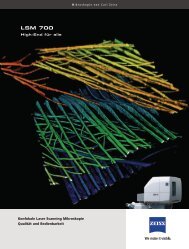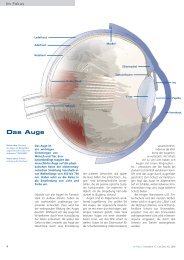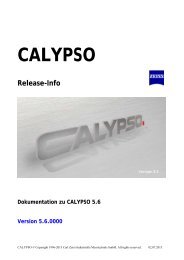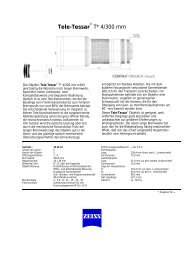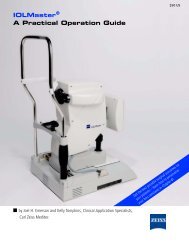FEMTO-LASIK and BEYOND - Carl Zeiss, Inc.
FEMTO-LASIK and BEYOND - Carl Zeiss, Inc.
FEMTO-LASIK and BEYOND - Carl Zeiss, Inc.
You also want an ePaper? Increase the reach of your titles
YUMPU automatically turns print PDFs into web optimized ePapers that Google loves.
26<br />
Ophthalmology WORLD REPORT<br />
The Importance<br />
of ReLEx in Our<br />
Current Laser<br />
Vision Correction<br />
Business<br />
ESCRS ReLEx smile Satellite Symposium Vienna, Austria<br />
Cataract & Refractive Surgery Today Europe<br />
e) Contrast Sensitivity<br />
followed by topographic smoothing to a depth of 58µm.<br />
At 7 months after the topo smoothing, UCVA was 20/100,<br />
refraction +4.25-4.25x180 (20/30). Corneal topographyguided<br />
PRK was done <strong>and</strong> at one <strong>and</strong> a half months post<br />
PRK, UCVA was 20/25, refraction +0.75D sphere (20/20).<br />
Summary: Dr Lim Bon Siong summarized that<br />
topography-guided ablations with the MEL 80 <strong>and</strong><br />
CRS-Master allowed regularization of corneas with<br />
irregular astigmatism resulting in the improvement of<br />
quality of vision.<br />
Dr Donald Tan, Medical Director, SNEC,<br />
Singapore, Chairman, Singapore Eye<br />
Research Institute<br />
Femtosecond laser assisted penetrating<br />
keratoplasty: Dr Tan shared the outcomes in a small<br />
series of 8 eyes (bullous keratopathy, Fuchs herpetic<br />
keratopathy, regraft) done at their center. The donor <strong>and</strong><br />
recipient trephined with femtolaser had a mean follow-up<br />
of 9.5 months <strong>and</strong> mean post-graft astigmatism of 2.56D.<br />
The mean endothelial cell count was 1.753 mm 2 <strong>and</strong> there<br />
weren’t any complications. “The potential of femtosecond<br />
lasers to perform deep stromal ablation will allow us to<br />
perform Femto-DSEK <strong>and</strong> Femto-DALK. Advantages,<br />
there is ease of surgery, improved bed quality <strong>and</strong> better<br />
accuracy in terms of depth of ablation. There should be<br />
better donor edge quality with no restriction to shape <strong>and</strong><br />
edge profiles <strong>and</strong> better lenticule profiles,” he said. Talking<br />
further he said that the disadvantages were “cost <strong>and</strong><br />
poor laser penetration of corneal scars. Arcus senilis is an<br />
issue. Many femtosecond lasers do not reach the good bed<br />
quality that we need. There are limitations because we are<br />
relying on the anterior corneal surface”. This in his view<br />
could be solved by linking with AS-OCT technology. <br />
Gradual <strong>Inc</strong>orporation of This Technique<br />
Has Led to Steady Growth.<br />
By Ekktet Chansue, MD<br />
ReLEx combines the latest femtosecond laser technology<br />
with an exact method for lenticule extraction within the<br />
intact cornea to achieve precise, accurate, <strong>and</strong> gentle<br />
vision correction. This procedure not only provides an easier<br />
approach to refractive correction, but it does so using just one<br />
device, the VisuMax femtosecond laser (<strong>Carl</strong> <strong>Zeiss</strong> Meditec,<br />
Jena, Germany). I transitioned to using ReLEx in July 2010<br />
<strong>and</strong> have since performed approximately 600 procedures.<br />
This article reviews my personal motivation behind the<br />
switch to ReLEx, demonstrates the benefits of transitioning to<br />
ReLEx flex <strong>and</strong> subsequently ReLEx smile, <strong>and</strong> lastly offers<br />
my unique perspective of marketing the procedure.<br />
Personal motivation: I am continually striving to achieve<br />
better refractive results for my patients. Part of this equation<br />
is the willingness to consider incorporating new procedures<br />
into daily practice. Throughout my career as a refractive<br />
surgeon, I have made a habit of objectively analyzing any<br />
new procedure that I am curious about, <strong>and</strong> if it makes sense,<br />
I consider adopting it. For instance, in 1994, I was the first<br />
surgeon in Thail<strong>and</strong> to perform <strong>LASIK</strong>. Looking back to that<br />
period, the procedure was being performed by only a h<strong>and</strong>ful<br />
of surgeons around the world—it was even considered an<br />
aggressive approach by a lot of ophthalmologists. But my<br />
objective analysis of <strong>LASIK</strong> told me that it would help me to<br />
achieve better postoperative outcomes compared with radial<br />
keratotomy, PRK (with first-generation excimer lasers), <strong>and</strong><br />
automated lamellar keratoplasty.<br />
<strong>LASIK</strong> is commonplace today, but I believe that laser vision<br />
correction is evolving from excimer laser-based ablation<br />
procedures to microincision surgery procedures like ReLEx<br />
smile. Like any other procedure I have considered for routine<br />
use, I performed an objective analysis of ReLEx <strong>and</strong> determined<br />
it may perhaps be the most ideal way to perform laser<br />
vision correction.


